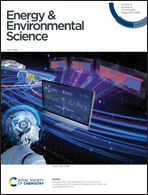Which dominates industrial–current–density CO2-to-C2+ electroreduction: Cuδ+ or the microenvironment?†
Abstract
The role and reconstitution of the architecture and oxidation state of Cu-based catalysts in the industrial–current–density CO2 electroreduction (ICD-CO2R) need to be fully understood. Herein, by utilizing operando/in situ spectroscopy, dendritic copper oxide with ultrahigh C2+ Faradaic efficiency in both acidic (77.0% at 0.7 A cm−2) and alkaline (82.6% at 0.9 A cm−2) media is employed as a prototype to provide scientific insights into the correlation between its dynamic structure and ICD-CO2R performance. Different from the general understanding, operando X-ray absorption fine structure spectroscopy indicated that active Cu+ sites tend to be stable during the ICD-CO2R both in acidic and alkaline media. Further COMSOL simulation and in situ Raman spectroscopy revealed that the dendritic morphology was found to enhance K+ enrichment, increase local pH values, and facilitate the adsorption of *CO intermediates in comparison to copper oxide particles. The comparative studies have confirmed that sharp morphologies play a crucial role in promoting the highly active ICD-CO2R rather than the oxidation state, of which the updated mechanism derived from these findings will significantly advance the industrialization of CO2R.



 Please wait while we load your content...
Please wait while we load your content...